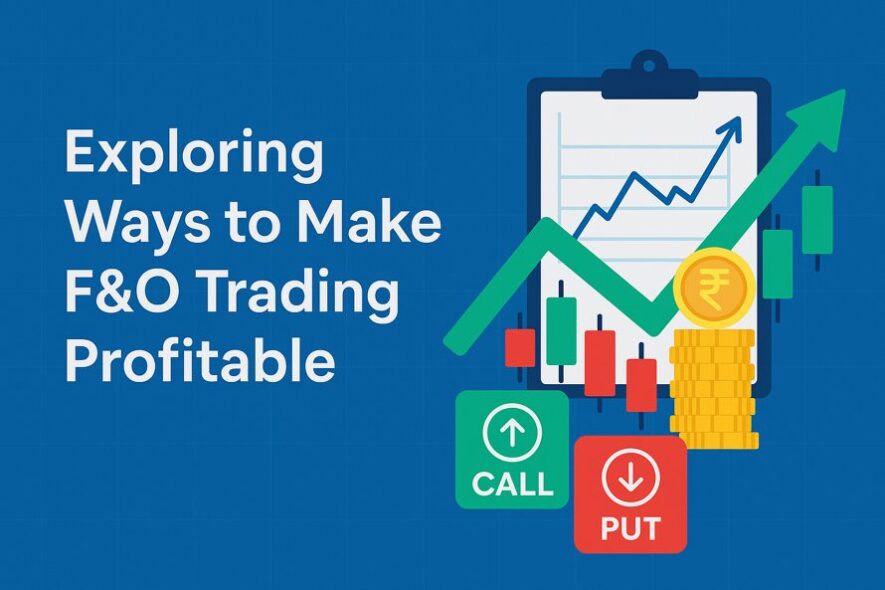
Introduction to F&O (Futures & Options) Trading
If you’ve ever wondered why some traders thrive in volatile markets while others struggle, the answer often lies in futures and options. Commonly referred to as F&O, these instruments allow traders to speculate on the future price movements of an asset without actually owning the asset.
But freedom cuts both ways. Futures and options can reward discipline or punish recklessness. To make F&O profitable, you need more than enthusiasm. You need to know how these contracts work, which strategies actually create an edge, and how to protect yourself when markets turn volatile.
Understanding How F&O Trading Works
At its heart, F&O trading is about contracts, not stocks. These contracts mirror the price of an underlying asset—an index, a stock, or even a commodity—and they give you the power to bet on movements, hedge risk, or capture volatility.
Futures Contracts Explained
Think of a futures contract as a handshake for tomorrow. Two parties agree today on a price at which they’ll buy or sell something in the future. If you expect the Nifty to climb, you go long on futures. If you expect it to dip, you short it. You don’t need to own the index itself—you just ride its movement. That ability to profit in both directions is why futures feel exciting. But they demand precision.
Options: Call vs Put
Options give you flexibility. A call option grants the right to buy at a set price, while a put option grants the right to sell.
That limited risk makes options powerful. Traders use them to speculate, hedge portfolios, or craft strategies that profit even in sideways markets. Think of options as the Swiss army knife of F&O—you can cut, slice, or simply protect yourself depending on how you use them.
Margins, Leverage & Risk Exposure
Here’s the catch. You don’t need full capital to enter an F&O trade. Brokers ask for a margin—a fraction of the contract’s value. That smaller outlay lets you control large positions, magnifying both gains and losses. This is leverage in action. It’s thrilling when the trade goes your way. It’s brutal when it doesn’t.
Key Strategies to Profit from F&O Trading
Strategies are what turn raw potential into consistent results. Markets reward preparation, not improvisation. Here are some tried-and-tested approaches that traders rely on to make F&O profitable.
Trend Following with Futures
Trends are the market’s way of speaking. Futures let you listen and act. When prices climb steadily, going long captures the ride. When they fall, shorting futures pays just as well.
But successful trend following isn’t about guessing. It’s about confirmation. Traders wait for breakouts, moving averages, or momentum cues before committing.
Hedging with Options
Options are the trader’s insurance policy. Imagine holding a stock portfolio. You don’t want to sell, but you fear a sudden drop. Buying put options creates a safety net. If markets fall, the puts rise in value, cushioning your portfolio.
Covered Calls and Protective Puts
These are the bread-and-butter of conservative options traders. A covered call involves holding a stock and selling a call option to generate income from the premium. A protective put flips the logic. You own the stock but also buy a put to protect against a significant stock price decline. If the stock dips, the put absorbs the pain.
Spread Strategies (Bull, Bear, Calendar)
Spreads are where options strategy gets clever. By combining two or more options, you shape risk and reward. A bull spread captures moderate upside, a bear spread handles gentle declines, and a calendar spread profits from the passage of time itself. The genius of spreads lies in their control. You know your maximum loss upfront, and you structure trades to fit specific market conditions.
Straddles and Strangles for Volatility
Sometimes you don’t care about direction—you just know something big is coming. Earnings season, a budget announcement, a policy decision. That’s when straddles and strangles shine.
A straddle is buying a call and a put at the same strike price. A strangle uses a call and a put with different strike prices, making it cheaper but needing a bigger move.
Risk Management in F&O Trading
F&O rewards the bold but protects the cautious. The traders who survive are those who respect risk as much as reward.
Position Sizing and Stop-Loss Rules
Every trader dreams of big wins. But professionals focus on small losses. They size positions so a single bad trade can’t wipe them out. Stop-loss orders enforce discipline, cutting off losses before they spiral. It’s not glamorous, but it’s what keeps accounts alive.
Avoiding Over-Leverage
Margins tempt traders into oversized bets. But over-leverage is the silent killer of F&O portfolios. The more capital you expose, the less room you have for error. Profitable traders deliberately keep positions smaller than they could, knowing survival is the real edge.
Diversification within Derivatives
Diversification isn’t just for stock portfolios. Even within derivatives, spreading positions across indices, sectors, or commodities balances risk. When one position falters, another steadies the account. It’s the difference between a rollercoaster equity curve and a manageable ride.
Technical & Fundamental Tools for Better Decision-Making
Profitable F&O trading thrives on preparation. Charts, indicators, and fundamentals combine to turn guesswork into informed action.
Using Indicators (MACD, RSI, Bollinger Bands)
Indicators aren’t magic, but they’re guides. MACD tracks momentum shifts, RSI spots exhaustion points, and Bollinger Bands reveal volatility squeezes. Used together, they help traders refine entries and exits.
Analyzing Open Interest and Volume Trends
Open interest tells you how many contracts are active. Rising open interest with price confirms strength. Falling open interest during a rally warns of weakness. Pair that with volume, and you can separate real moves from false starts. Traders who watch these numbers often see the story before the charts fully show it.
Earnings and News-Based Option Plays
Events move markets. Earnings reports, RBI policies, global news—they all bring volatility. Traders use options to prepare, buying calls or puts ahead of events. It’s risky, yes, but when research aligns with timing, these trades deliver outsized rewards.
Psychological Edge: Trader Mindset for Consistency
Ask any veteran, and they’ll admit: the most challenging part of trading isn’t the charts or numbers—it’s managing yourself.
Discipline & Emotion Control
Greed whispers, “Stay longer.” Fear says, “Exit soon.” Anger shouts, “Revenge trade.” The traders who win long term silence those voices with discipline. They follow plans, respect stop-losses, and treat trading like a business, not a casino.
Learning from Losses
Losses are tuition fees. Everyone pays them. The difference is whether you treat them as sunk costs or lessons. Reviewing what went wrong—wrong entry, wrong timing, or ignoring rules—prevents the same mistake twice. That’s how consistency is built.
Journaling Trades & Reviewing Performance
A trade journal may sound boring, but it’s a trader’s diary of progress. Recording entries, exits, and emotions creates a personal database of lessons. Over time, patterns emerge: your strengths, your weak spots, and the tweaks that boost performance.
Tools & Platforms to Enhance F&O Profitability
Technology is the trader’s silent partner. The right platform saves time, reduces errors, and highlights opportunities faster than manual methods.
Trading Terminals and F&O Scanners
Modern terminals go beyond simple charts. They offer live data, order book depth, and scanners that track unusual activity. A sudden spike in open interest or a surge in volume? Scanners catch it before the news does.
Brokerage Cost Considerations
Costs matter. Each trade carries brokerage, and frequent F&O trading means fees add up. Choosing brokers with competitive pricing ensures more of your profit stays where it belongs—in your account.
Learning Resources and Simulation Tools
F&O is a skill, and skills sharpen with practice. Simulation tools let you test strategies in real-time without risking money. Pair them with webinars, books, and courses, and you build a foundation strong enough to tackle live markets.
Taxation and Compliance for Profitable F&O Traders
In India, profits from F&O trading are treated as business income. That means proper record-keeping, filing under the right category, and paying advance tax when required. Many traders also deduct expenses like internet bills, research subscriptions, or office costs.
Common Mistakes to Avoid in F&O Trading
The same pitfalls appear again and again. Over-leveraging positions. Ignoring stop-losses. Jumping into trades without research. Trading on impulse after a loss. Each of these habits eats into capital faster than a bad market move. Avoiding them is as important as learning strategies.
Conclusion
F&O trading is a high-potential area. Futures capture trends. Options protect portfolios and open creative strategies. Together, they give traders a toolkit to profit from any market condition.
But to truly make F&O profitable, you need more than contracts and charts. You need risk management, discipline, and the right mindset. Combine technical tools, structured strategies, and psychological control, and F&O shifts from speculation to skill.
Profitability comes from consistent execution, month after month. Trade like a professional, protect your capital, and let the compounding of discipline turn opportunity into wealth.
FAQs:
Q. Can you really make consistent profits in F&O trading?
Yes, with discipline and risk control. Consistency comes from following a plan, not chasing every move.
Q. What are the best F&O strategies for beginners?
Covered calls, protective puts, and simple spreads are safer for beginners. They limit risk while teaching the basics.
Q. How much capital is needed to trade F&O profitably?
Enough to meet the margin comfortably and diversify trades. Starting too small often pushes traders into risky leverage.
Q. Is F&O trading better than equity investing?
Neither is “better.” Equities build long-term wealth, while F&O suits active traders looking for short-term opportunities.
Q. How is F&O income taxed in India?
F&O profits are taxed as business income under normal slabs. Expenses linked to trading can be claimed as deductions.
Q. What percentage of traders lose money in F&O?
SEBI studies show that most retail traders lose money, mainly due to over-leverage and poor discipline.




